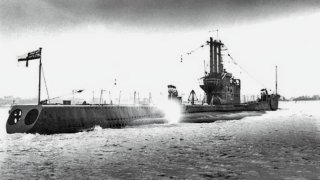The Royal Navy Lost an Attack Submarine and Still Can't Explain Why
In 1951, the Royal Navy suffered a significant tragedy with the loss of HMS Affray, an A-class submarine designed during World War II to operate in the Far East. The Affray departed Portsmouth on April 16 for a simulated war patrol with an unusually large crew, including trainees and Royal Marines.
What You Need to Know: In 1951, the Royal Navy suffered a significant tragedy with the loss of HMS Affray, an A-class submarine designed during World War II to operate in the Far East. The Affray departed Portsmouth on April 16 for a simulated war patrol with an unusually large crew, including trainees and Royal Marines.
-The last communication was received at 8:56 pm, stating their intent to dive and resurface the next morning. When no surfacing signal came, a massive search operation was launched, eventually locating the wreck.
-Despite various theories—ranging from mechanical failure to crew error—the exact cause remains unknown. The disaster led to a review of submarine escape systems and marked the last time the Royal Navy lost a submarine with all hands.
The Royal Navy's A-Class Submarine Disaster
Great Britain's Royal Navy has been fortunate to largely avoid significant submarine accidents since the Second World War. However, in addition to the early 1950 collision involving HMS Truculent, the UK's senior service suffered a serous tragedy involving a six-year-old A-class submarine – and it would be fair to describe it as a "Class A Disaster."
Development of the A-class – also known as the Amphion class – began in 1942 with the goal to produce a submarine that offered superior speed, range, and crew conditions to the Royal Navy boats already in service. As London found itself in a war both in Europe and the Pacific, there was suddenly a need for a submarine that could operate in the Far East. The A class was noted for incorporating many elements taken from captured German Kriegsmarine U-boats, while the subs featured a modular manufacturing process that included all-welded hulls.
As they were designed for service in the Indian and Pacific Oceans, the A class was unique for the era in that the submarines were equipped with air conditioners and even refrigeration. However, in addition to the creature comforts, the submarines were armed with 10 torpedo tubes. Originally plans called for 46 A-class boats to be constructed but the war ended as just 16 had been built – and most were only entering service.
The Tragedy of the Affray
Among the completed A-class submarines was HMS Affray (P-421), which had been laid down in January 1944 but only commissioned in November 1945, after the war had come to an end.
On April 16, 1951, the submarine headed out of Portsmouth on a simulated war patrol exercise with an unusually large number of men on board. Under the command of Lt. John Blackburn, P-421 carried four officers and 55 ratings (sailors), along with an additional 23 young sub-lieutenants who were along for training that included observing a war patrol. Four Royal Marines also were on board the sub during that faithful voyage.
Lt. Blackburn was ordered to proceed down the English Channel to the Western Approaches, where he was to carry out dummy attacks for three days. The junior officers were to observe and gain experience for future service on Royal Navy subs. The marines were also to be deployed at a bay on the Cornish coast.
Though it sounded complicated, it was routine for a war patrol.
At 20:56 hours (8:56 pm) the commanding officer signaled near the Isle of Wight that he intended to dive and proceed westwards, with plans to surface at 08:00 hours (8:00 am) the following day. That was the last that anyone heard from HMS Affray.
No surfacing signal was received and by 09:00 hours a Royal Subsunk operation was launched. By midday on April 17, a total of 40 ships, eight submarines, and a variety of Royal Air Force (RAF) and the Fleet Air Arm began a search for the missing submarine. A flotilla of U.S. Navy destroyers that had been visiting Plymouth also took part in the search.
Just 46 hours after the Subsunk began the massive search operation for HMS Affray was stood down. The search and rescue became a search and recovery, handed over to a smaller team that included four Royal Navy frigates and three minesweepers equipped with special electronics that could conduct underwater searches.
The effort lasted 59 days and covered more than 37,000 km (23,000 miles). It further involved investigating more than 160 shipwrecks, some dating back centuries – as the English Channel has been a watery grave for eons.
However, the wreck of HMS Affray was finally found.
The cause of the accident has many theories but no solid answers, even all these decades later. Royal Navy divers discovered the snort mast on the boat had broken off, but determined that likely occurred after the submarine hit the bottom. Theories include errors made by the crew during training, mechanical failure, and even a battery explosion.
Though no firm conclusion has been determined, the HMS Affray tragedy did result in a review of submarine escape systems. Fortunately, she was also the last Royal Navy submarine to be lost with all hands.
Author Experience and Expertise: Peter Suciu
Peter Suciu is a Michigan-based writer. He has contributed to more than four dozen magazines, newspapers, and websites with over 3,200 published pieces over a twenty-year career in journalism. He regularly writes about military hardware, firearms history, cybersecurity, politics, and international affairs. Peter is also a Contributing Writer for Forbes and Clearance Jobs. You can follow him on Twitter: @PeterSuciu. You can email the author: [email protected].
Image Credit: Creative Commons.


